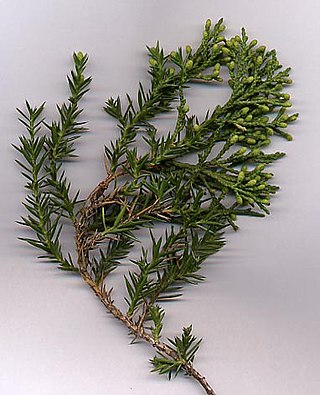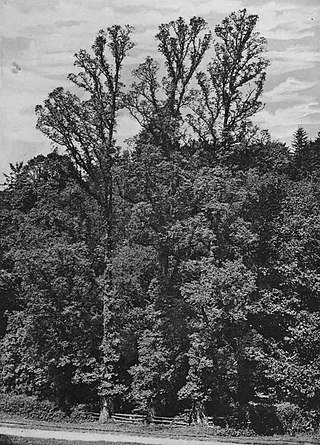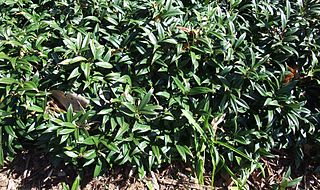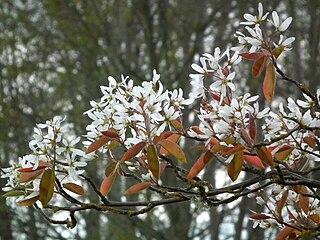
Juniperus chinensis, the Chinese juniper is a species of plant in the cypress family Cupressaceae, native to China, Myanmar, Japan, Korea and the Russian Far East. Growing 1–20 metres tall, it is a very variable coniferous evergreen tree or shrub.

The Royal William rose, registered under the cultivar name "KORzaun", is a red hybrid tea rose. It was developed by Reimer Kordes from the cultivar 'Feuerzauber' and is available under several other marketing names, such as Fragrant Charm, Duftzauber, La Magie du Parfum and Leonora Christine.

Sir Harry James Veitch was an eminent English horticulturist in the nineteenth century, who was the head of the family nursery business, James Veitch & Sons, based in Chelsea, London. He was instrumental in establishing the Chelsea Flower Show, which led to his being knighted for services to horticulture.

The field elm cultivar Ulmus minor 'Stricta', known as Cornish elm, was commonly found in South West England, Brittany, and south-west Ireland, until the arrival of Dutch elm disease in the late 1960s. The origin of Cornish elm in England remains a matter of contention. It is commonly assumed to have been introduced from Brittany. It is also considered possible that the tree may have survived the ice ages on lands to the south of Cornwall long since lost to the sea. Henry thought it "probably native in the south of Ireland". Dr Max Coleman of Royal Botanic Garden Edinburgh, arguing in his 2002 paper on British elms that there was no clear distinction between species and subspecies, suggested that known or suspected clones of Ulmus minor, once cultivated and named, should be treated as cultivars, preferred the designation U. minor 'Stricta' to Ulmus minor var. stricta. The DNA of 'Stricta' has been investigated and the cultivar is now known to be a clone.

The Davey Elm, Ulmus × hollandica 'Daveyi', is an English hybrid cultivar of unknown specific origin, generally restricted to the valleys of Cornwall. Its apparent south-west England provenance, along with its foliage and habit, suggest that it may be a hybrid of Wych Elm and Cornish Elm.

Escallonia is a genus of shrubs and trees in the family Escalloniaceae. They are native to North and South America.

Chaenomeles speciosa, the flowering quince, Chinese quince or Japanese quince, is a thorny deciduous or semi-evergreen shrub native to eastern Asia. It is taller than another commonly cultivated species, C. japonica, usually growing to about 2 m. The flowers are usually red, but may be white or pink. The fruit is a fragrant, hard pome that resembles a quince.

The 'dwarf' elm cultivar Ulmus 'Jacqueline Hillier' ('JH') is an elm of uncertain origin. It was cloned from a specimen found in a private garden in Selly Park, Birmingham, England, in 1966. The garden's owner told Hillier that it might have been introduced from outside the country by a relative. Hillier at first conjectured U. minor, as did Heybroek (2009). Identical-looking elm cultivars in Russia are labelled forms of Siberian Elm, Ulmus pumila, which is known to produce 'JH'-type long shoots. Melville considered 'JH' a hybrid cultivar from the 'Elegantissima' group of Ulmus × hollandica. Uncertainty about its parentage has led most nurserymen to list the tree simply as Ulmus 'Jacqueline Hillier'. 'JH' is not known to produce flowers and samarae, or root suckers.

Buddleja crispa, the Himalayan butterfly bush, is a deciduous shrub native to Afghanistan, Bhutan, North India, Nepal, Pakistan and China, where it grows on dry river beds, slopes with boulders, exposed cliffs, and in thickets, at elevations of 1400–4300 m. Named by Bentham in 1835, B. crispa was introduced to cultivation in 1850, and came to be considered one of the more attractive species within the genus; it ranked 8th out of 57 species and cultivars in a public poll organized by the Center for Applied Nursery Research (CANR) at the University of Georgia, US. In the UK, B. crispa was accorded the Royal Horticultural Society's Award of Merit in 1961. However, the species is not entirely cold-hardy, and thus its popularity is not as ubiquitous as it might otherwise be.

Clerodendrum trichotomum, the harlequin glorybower, glorytree or peanut butter tree, is a species of flowering plant in the family Lamiaceae. It is native to China, Korea, Taiwan, Japan, India, and the Philippines.

Sarcococca hookeriana, the Himalayan sweet box, is a species of flowering plant in the box family Buxaceae, native to China, Afghanistan, North East India, Bhutan and Nepal. It is a low-growing evergreen shrub, usually growing to 12–24 in (30–61 cm) high. It produces aromatic white flowers throughout winter, followed by black berries.

Camellia × williamsii is a cultivar group of hybrid evergreen shrubs that are derived from a crossing of Camellia saluenensis with Camellia japonica. It was originally bred in 1923 at Caerhays Castle in Cornwall by John Charles Williams.

Buddleja officinalis is a deciduous early-spring flowering shrub native to west Hubei, Sichuan, and Yunnan provinces in China. Discovered in 1875 by Pavel Piasetski, a surgeon in the Russian army, B. officinalis was named and described by Maximowicz in 1880. Introduced to western cultivation in 1908, B. officinalis was accorded the Royal Horticultural Society's Award of Merit three years later, and the Award of Garden Merit in 2002.

Buddleja madagascariensis, the smokebush or Madagascan butterfly bush, is a species of flowering plant in the figwort family Scrophulariaceae. It is a substantial evergreen shrub with fragrant yellow flowers through autumn and winter.

Philadelphus × purpureomaculatus is a flowering plant in the family Hydrangeaceae, of garden origin. It is a hybrid between Philadelphus × lemoinei and P. mexicanus 'Rose Syringa'. Growing to 1.2 m (4 ft) tall by 2 m (7 ft) broad, it is a deciduous shrub with broadly oval leaves up to 5 cm (2 in) long, and single, cup-shaped flowers in summer. The flowers, which are strongly fragrant, are pure white with prominent purple markings near the centre; hence the Latin specific epithet purpureomaculatus, literally "purple spotted".

Amelanchier × grandiflora, the serviceberry, is a small deciduous flowering tree or large shrub, a hybrid of garden origin between A. arborea and A. laevis, in the family Rosaceae. It produces white flowers and small red to purple edible fruits.

Escallonia bifida, the cloven gum box, is an evergreen shrub or small tree in the family Escalloniaceae. It is native to Brazil and Uruguay.

The Field Elm cultivar Ulmus minor 'Dicksonii', commonly known as Dickson's Golden Elm, is a yellow-leaved tree raised in Chester in 1900 by Dickson's Nursery, which distributed it from the autumn of 1907 as 'Golden Cornish Elm'. 'Cornish Elm' was the name often given in error to Guernsey or Wheatley Elm by the local authorities who planted the latter extensively, an error which may have influenced the choice of name by Dickson's nursery. 'Dicksonii' is usually listed as a variety of Guernsey Elm rather than Cornish Elm, Bean giving 'Wheatleyi Aurea' as a synonym, and Hillier 'Sarniensis Aurea' and later U. × sarniensis 'Dicksonii'. Clibrans' nursery of Altrincham, however, described it (1922) as otherwise identical "in habit and constitution" to 'type' Cornish Elm. The Späth nursery of Berlin distributed it from c.1913 as U. campestris cornubiensis Dicksonii. The nursery Messieurs Otin père et fils of Saint-Étienne sold an Ulmus Wheatleyi aurea pyramidalis, with leaves marbled yellow, in 1882, earlier than Dickson's introduction.

Escallonia rubra, called redclaws and red escallonia, is a species in the family Escalloniaceae which is native to southern Chile and neighboring areas of Argentina.

Rosa 'Gertrude Jekyll' is a pink shrub rose cultivar, bred by British rose breeder, David C. H. Austin in 1986. It was named in honour of the famous British writer and garden designer, Gertrude Jekyll (1843–1932). 'Gertrude Jekyll' is one of the most popular of the David Austin's English roses. It was awarded the Royal Horticultural Society's Award of Garden Merit in 1994.




















